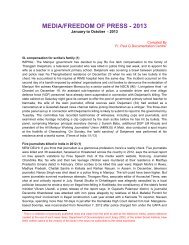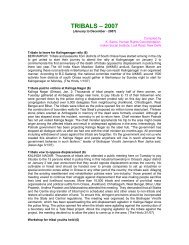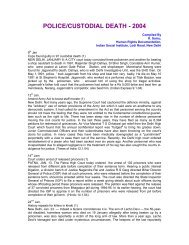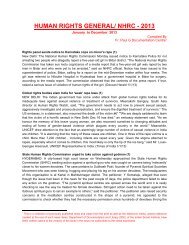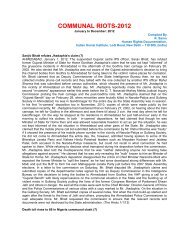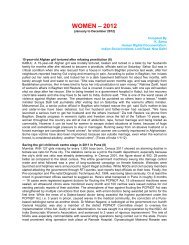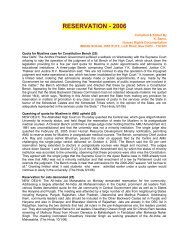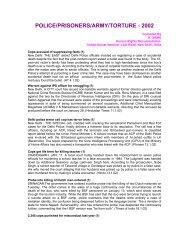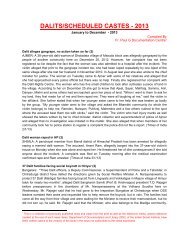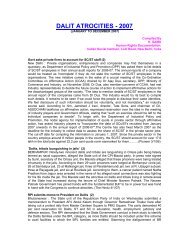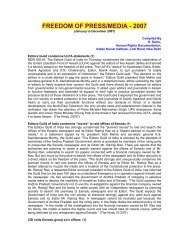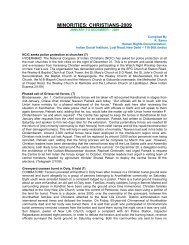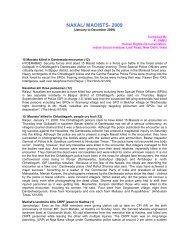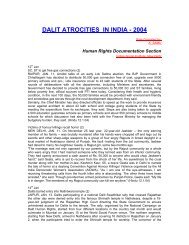TRIBALS - 2012 - Indian Social Institute
TRIBALS - 2012 - Indian Social Institute
TRIBALS - 2012 - Indian Social Institute
You also want an ePaper? Increase the reach of your titles
YUMPU automatically turns print PDFs into web optimized ePapers that Google loves.
(BBJM) took out a rally from 'martyrs column' in Champakoila village to Veerbhumi at Ambagadia, where<br />
the tribals had been killed and vowed not to spare an inch of land for the steel plant. Family members and<br />
relatives of firing victims offered rituals at Ambagadia also. Prafulla Samantray, an anti-land acquisition<br />
leader and president of Lokshakti Abhijan, accused chief minister Naveen Patnaik of working for private<br />
industrial houses at the cost of the masses, who voted him to power. He said Naveen is least interested in<br />
the development of tribals. "He has not bothered to visit Kalinga Nagar even after six years of the firing<br />
speaks volumes of his mindset," he said. "Odisha has about 97 per cent chromite, 71 per cent bauxite, 33<br />
per cent iron ore and 32 per cent manganese resources of India. As commodity prices soar, international<br />
companies are eyeing this mineral bounty, much of which is in tribal territory," said Mahendra Parida, a<br />
leader of CPIML (Liberation). The anti-industry leaders vowed not to allow industries. "We won't tolerate<br />
torture of innocent tribals. There shouldn't be any industry at the cost of tribals and their livelihood. Our<br />
fight against industrialisation will continue till the government changes its decision to set up industries on<br />
farm land. Fourteen of our fellowmen sacrificed their lives for the cause of tribals. We are ready to die but<br />
will not spare an inch of land for industry," said Rabindra Jarika, secretary of BBJM. On the other hand ,<br />
about 800 people led by Visthapita Parivar Unnayan Parishad, a pro-industry outfit participated in a rally<br />
at Tata's rehabilitation colony at Gobarahat village. They were led by president Dhaneswar Soi and<br />
secretary Biren Jamuda. Though the two parallel meetings were held at a short distance of each other,<br />
there was no clash between the rival groups. "The rally and meetings passed off peacefully. We deployed<br />
six platoons of police force to check any untoward incident," said K C Mund, the police officer of<br />
Kalinganagar police station. (Times of India 3/1/12)<br />
In Chhattisgarh village, cops see human sacrifice in girl’s mystery death (6)<br />
Bijapur It’s been two and a half months since seven-year-old Lalita Tati went missing from her village in<br />
Chhattisgarh’s Bijapur district. Six days later, the child’s parents found her decomposed, mutilated body,<br />
with nearly all organs missing. Amid talk of grisly local custom in this impoverished tribal area, police have<br />
arrested two men who they allege killed Lalita to propitiate a bloodthirsty female deity. Lalita went missing<br />
on October 21. Her father, Budhram Tati, discovered her body on October 27. The autopsy report said<br />
“cause of death cannot be ascertained as the body parts were eaten away by maggots”. Nearly all of<br />
Lalita’s organs, including the liver, were missing, the report said. The Bijapur police initially suspected a<br />
rape-murder, but last week arrested Sukku Padam, a resident of Jailwara village where Lalita lived with<br />
her parents, and Ignesh Kujur of Toornar village. “They have confessed that they cut her body and offered<br />
her liver to the goddess to ensure a good harvest,” superintendent of police R N Dash said. The police<br />
have sent samples from Lalita’s body to the forensic science laboratory in Raipur. Local councillor Vella<br />
Ram, who is Tati’s neighbour in Jailwara, a village that came into existence some years ago to house<br />
tribals displaced by Naxalite violence, especially after the Salwa Judum rising, argued that Sukku would<br />
have had no reason to kill Lalita. “Sukku is not a farmer, just a poor daily labourer. How can he sacrifice<br />
someone for a harvest? The place where the body was found is around 15 km from the temple named by<br />
the police.” Ignesh Kujur’s son, Anil, said they were Christian and did not believe in sacrifices. Lalita’s<br />
cousin Narayan too said human sacrifice was not heard of in the community. Several local people alleged<br />
the police had forced a confession out of Sukku and Ignesh. Dash said the fact of Ignesh being Christian<br />
established nothing. “Many of them worship local deities jo kisi khaas tribe ka khoon peeti hain. Sukku is<br />
a priest of the same deity’s temple at Kadenar. The duo told us that their goddess wanted the blood of the<br />
Agriya tribe, to which Lalita belonged.” The murder weapon has been recovered, the SP said. “Lalita was<br />
seven years old. Tribals often sacrifice children whose ages are in odd numbers, like 7, 9, 11.” He said<br />
money had been found at the feet and head of the body, indicating that two people had offered the<br />
sacrifice. Lalita’s father Budhram alleged that police had locked him up for 11 days. “They tortured me,<br />
wanted me to admit that I had either raped or killed or sacrificed my daughter,” he said. Dash denied the<br />
charge: “Tribals here often sell their children. We had suspicions, so we interrogated Budhram.” (Express<br />
India 6/1/12)



